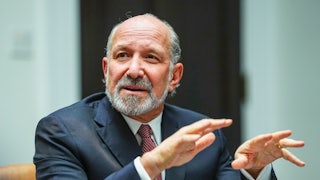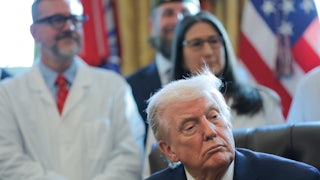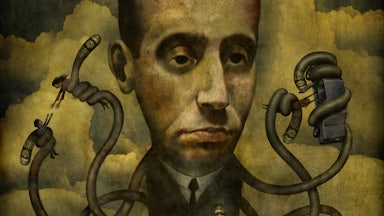Stakes
University politics are so vicious because the stakes are so low. Good old Sayre’s Law, coined in 1973. Funny while it lasted. May it find eternal life in meme heaven.
It’s been ages since university politics meant student-faculty sex scandals, petty tenure battles, a ruinous typo in Studies in Romanticism. Jokes about academia’s pitiful stakes no longer slay. Just as he’s totaled so many U.S. laws, Donald Trump has blown Sayre’s to atoms.
The stakes of university politics are now stratospheric. Even as new global zones are flooded with Steve Bannon’s strategic shit—disorienting lies about tariffs, rogue immigrants, the “client list” of Jeffrey Epstein—Trump is still using ICE, extortion, pressure campaigns, and federal lawfare to bring about academic regime change and convert universities into MAGA indoctrination camps.
Sure, if you read only the reflections of cultural dons like Ross Douthat and Larry Summers in The New York Times, you could be forgiven for thinking that all campuses are Harvard, and that all academics are still stuck in the tedium of woke/anti-woke pickleball. But it’s much darker than that. The administration is explicitly trying to commandeer university administrations and curricula. The Justice Department’s late-June expulsion of the president of the University of Virginia, my alma mater, was an especially nasty blow to the basic principles of academic freedom. And Trump is not only laying waste to the arts and sciences. His sadistic reconciliation bill will vaporize student debt relief and reduce the ability of working families to get grants that can cover tuition. As Astra Taylor and Eleni Schirmer have argued, this plan all but ensures that no one but the rich can ever go to college again.
Higher education in the United States is far from a monolith. And though the media’s klieg lights have been trained on the Ivy League, from which so many high-profile journalists graduated—as well as Donald Trump (Penn Wharton, 1968) and JD Vance (Yale Law School, 2013)—there are some 6,000 other colleges and universities out there across the country. Many are silent on Trump’s pedagogical edicts. But some are standing up. The Big Ten conference, in particular, has mounted a formidable defense during the Trump blitzkrieg. Its stance, a blunt assertion of its own power, could be a model for other coalitions squaring off with the administration. The conference’s tactics of deterrence, cohesive teamwork, and tone-setting have made for exemplary gameplay. It’s almost as if those universities had some experience with football.
B1G
The Big Ten, to begin with, was not impressed by Columbia University’s early decision to cave to Trump’s demands. In May, Greg Beitel, a molecular biosciences professor at Northwestern, told the student newspaper that he gave up on appeasing the administration after seeing Columbia’s mortifying acquiescence to federal demands in March.
Nor were professors in the Big Ten conference especially wowed by Harvard’s much-praised two-step: mounting an opulently capitalized legal defense of higher education while continuing to truckle behind oaken doors. After quietly folding to the billionaire-funded right-wing campaign to drive out its first Black president and renaming its graduate school of arts and sciences (my other alma mater) for GOP megadonor Ken Griffin, Harvard quietly renamed its DEI office in April—and dismantled DEI entirely in July.
Then, in late June, after weeks of legal chest-beating, Harvard reps rolled out a dutiful deck to White House officials, showing steps the school had taken to de-woke-ify—including adjusting admissions policies and possibly opening a right-wing think tank. On June 27, it announced that foreign students in the business and public-policy schools, if barred from the United States by the Trump administration, can finish their degrees at the University of Toronto.
Sending people to Canada and genuflecting before the White House is not the Big Ten way. The Buckeyes, Wolverines, Hoosiers, Spartans, Boilermakers, Badgers, and the rest prefer big, fat touchdowns to the cloak-and-dagger of the global aristocracy. The whole conference, now 18 universities across 16 states, exists to dominate. And it does dominate. While the media has fixated on the Ivies, the Big Ten have lain in wait, an interstate alliance with protections from statehouses red and blue, 810,000 potential student foot soldiers, and a world-renowned talent for high-stakes strategy games. With its very own Big Ten Network, which it co-owns with Fox, the conference is now on track to make as much as $1.4 billion in untaxed revenue from media rights deals, bowl prizes, and other revenue streams this year—a staggering feat considering the annual revenue of the whole NCAA is not much more than that. If the Big Ten were a publicly traded company, its market capitalization could be up to $30 billion.
Academically, the Big Ten’s assets are even greater: $18.4 billion in annual research and 145 million library volumes, more than twice the holdings of the Ivy League. Five of the Big Ten universities—Illinois, Penn State, Ohio State, Purdue, and Wisconsin—have nuclear reactors. There are more quantum computing facilities in the Big Ten than in all of Europe.
Finally, there’s on-the-ground muscle. Penn State and Indiana University have two of the largest police forces of any universities in the United States, each one boasting more sworn police officers than Harvard and Princeton combined. The Big Ten alliance is, in short, an academic, athletic, and financial juggernaut with real-world power—and its devout fans don’t like to see it pushed around. Oh yes. The fans. For the love of God: The Big Ten has more than 44 million of them.
The “Academic NATO” Springs to Life
Like so much of the global polycrisis convulsed by the second Trump administration, the chaos in academia was foretold. “We have to honestly and aggressively attack the universities in this country,” resolved JD Vance in 2021. On the stump, Trump pushed into Turner Diaries territory: “We are going to choke off the money to schools that aid the Marxist assault on our American heritage and on Western civilization itself.”
Freshly MAGA-deranged Republicans, though formerly staunch supporters and beneficiaries of college education, lapped up the venom. By July of last year, fully 50 percent of Republicans reported they had “little or no” confidence in higher education, up from only 11 percent in 2015, when diversity initiatives enjoyed broad popular support. In those days, bitter gags about reverse racism by William Luther Pierce—“Unless a book was written by a militant lesbian, a revanchist American Indian, or a Negress with AIDS who’d converted to Judaism, it was suspect”—were only for neo-Nazis like Pierce himself, the actual author of The Turner Diaries.
Certainly, there are plenty of conservatives in power at Big Ten universities. By 2024, many had no doubt fallen for the right-wing fads of anti-wokery or unabashed racism or both. But no one was prepared for what Trump would actually do to smite universities. On January 27, one week after he took office, he signed more than two dozen executive orders addressing higher ed, many aimed at punishing nonexistent racism against white people. In this monarchal orgy, Trump ordered that Immigration and Customs Enforcement be allowed into schools and onto college campuses, formerly sacrosanct places off limits to immigration enforcers. This paved the way for the extrajudicial March arrests and detentions of several peaceful campus activists, including Mahmoud Khalil at Columbia and Rümeysa Öztürk at Tufts.
In the now-notorious “Dear Colleague” letter of February 14, the Department of Education then tried to shake down all U.S. schools that take even a dollar of federal money, from kindergartens to postdoc programs. Eliminate DEI protections in 14 days or risk your funding. That letter reaped the whirlwind. Over the next two weeks, the American Federation of Teachers, American Sociological Association, the American Civil Liberties Union, and the National Education Association all filed lawsuits arguing, variously, that the DOE misinterpreted the law and violated the First and Fifth Amendments. (In late April, in two separate rulings, federal judges found that the letter was improperly issued and put a temporary halt to any enforcement of its provisions.)
On March 10, the Trump administration sent another protection-racket letter to 60 colleges and universities threatening, them with punishment if they didn’t suppress campus speech on the pretext of protecting Jewish students. (Weeks later, 10 leading Jewish groups issued a statement saying these students were actively endangered by Trump’s bad-faith crackdown on “antisemitism.”) On the watch list were eight Big Ten schools: Indiana University Bloomington; Ohio State University; Rutgers University; University of Wisconsin-Madison; University of Washington-Seattle; University of Michigan; University of Minnesota; and Northwestern.
As for federal disruptions for students at the Big Ten, at least 136 conference students—and likely many more, given the privacy of Northwestern and USC, and secrecy of the Department of Homeland Security and ICE—have had their visas revoked. In March, ICE abducted Doğukan Günaydın, an MBA student at the University of Minnesota, and he was detained for eight weeks without charges. In late May, his detention was declared unconstitutional. “Fifty-six days, I did not see the sun or the sky,” Günaydın said when released. At the University of Michigan, student activists are being surveilled, intimidated, and even run off the road by undercover investigators.

In response to Trump’s bullying, the university senate at Rutgers settled on a plan. They’d make a display of conference unity and force, show Trump the glint of a major institutional knife. It was perfect timing. Outsiders, especially those who mistake Harvard for the whole of higher education, often envision the Big Ten as apolitical or cornfield-conservative and focused solely on athletics. They don’t realize that the Big Ten has spread beyond the industrial Midwest, and now includes UCLA, USC, and the universities of Washington and Oregon.
The university senate at Rutgers left no doubt about the scale of the conference. It passed a resolution that established what one of its authors memorably called an academic NATO for the Big Ten. While the compact stops short of discussing military defense, the bold document nonetheless changed the dynamics of the bowl game with Trump. Written by psychology professor Paul Boxer on the Newark campus and chemistry professor David Salas-de la Cruz at Camden, the Rutgers resolution lays out the Trump administration’s strong-arm efforts to suffocate universities. It then calls on Big Ten conference members to pool financial, legal, and PR resources to coordinate a “unified and vigorous” response to federal incursions and defend any member school facing “improper control over academic inquiry.”
“The goal of the Mutual Academic Defense Compact is threefold: protect academic freedom, defend institutional integrity, and promote the scholarly enterprise,” Boxer told me in May. He and his Big Ten colleagues, he said, are “deeply concerned on an existential level about the entire enterprise of higher education.”
In short, the compact was an aggressive power grab passing as a polite letter to the editor. We’re on watch, you say? No, Mr. President, we’re the goddamn Big Ten. You’re on watch. Boxer now speaks of his conference less in the vibey terms beloved of Ivy Plus schools—elite, illustrious, prestigious—and more as a kind of empire. The Big Ten has, he told me, “a broad public service mission, vast intellectual resources, and unyielding ethical responsibilities.”
The Rutgers senate committed to the compact on March 28. In rapid succession, university senates at 13 of the other 17 Big Ten schools drafted similar resolutions. Mutual defense compacts passed senates at Indiana University Bloomington (April 8), Michigan State (April 15), University of Michigan (April 17), University of Nebraska-Lincoln (April 17), University of Washington (April 17), Ohio State (April 24), University of Maryland (April 24), University of Minnesota (April 24), University of Illinois at Urbana-Champaign (April 28), Penn State (April 29), University of Oregon (April 30), University of Wisconsin-Madison (May 5), and Northwestern University (May 7). Since then, faculty at 44 non–Big Ten universities, from the University of Massachusetts to the University of Arizona, have signed their own analogous resolutions.
The compact won widespread coverage, and not just on nerdy Substacks. Rachel Maddow called her segment on the compact “Don’t Fight Alone.” The New York Times said the compact had helped “shift the tone of the national debate.” Axios called it “an escalation in resistance” to the Trump administration.
Nonetheless, the presidents and administrations of all 18 conference universities distanced themselves from the compact. Instead, four weeks after Rutgers signed the first one, 10 Big Ten presidents joined hundreds of others—now 659—in signing a statement issued by the American Association of Colleges and Universities. The statement is restrained but stern: “We speak with one voice against the unprecedented government overreach and political interference now endangering American higher education.”
And the Big Ten is still at it. In June, four schools in the conference—Michigan State, Rutgers, the University of Maryland, and the University of Oregon—joined 14 other universities in filing an amicus brief in Harvard’s lawsuit that challenged the Trump administration’s suspension of billions of dollars in funding. The brief argued that the administration’s bellicosity toward Harvard would have dire consequences for scientific research. And the Big Ten law schools have also hosted “The Rule of Law in 2025,” a series of panel discussions about the damage the Trump administration has done to the law itself.
True, statements by professors won’t protect institutions from Trump. But you know who does care about the strong stance of university intellectuals? Students. They’re more politically active now than they have been in years. According to a spring survey by the United Way, fully 40 percent of college students are now regularly engaged in activism and social-justice work, compared to only 24 percent of millennials, now ages 29 to 44. Seventy percent of college-age activists say their focus is racial equity, which they see as imperiled by Trump.
There are nearly 75,000 instructional staff in the Big Ten. These alpha minds, who are trained and incentivized to pursue truth over profit, preserve and advance the American tradition of inquiry. They also hold the keys to the future of aerospace, biotech, quantum, AI, and nuclear physics. Their mutual defense compact is a show of intellectual vibrancy and I-am-Spartacus citizen risk-taking. Their audience is not, for once, Trump. It’s the young people who have come from across the country and around the world, often at great expense, to study at U.S. universities, which have long been among our nation’s undisputed masterpieces. As Trump has aimed to sterilize intellectual life and forced the olds into blue and red holding pens, it’s down to the students to call us back to our more passionate and longer-standing commitments—to our schools, cities, states, sports teams, community alliances, and principles.
As Boxer, whose academic work is on how aggressive behavior develops, waits for the challenges to Trump’s overreach to make it through the courts, he continues to try to influence his university’s administration. “They could be leveraging the fact that they have a formal academic alliance of 18 of the biggest universities and offer a joint statement affirming the dramatic importance of higher education,” he said. “But they don’t…. And imagine if the Big Ten Network said: You know what, sports are important, but we want to protect the integrity of our entire institutions. So every Big Ten football game we broadcast is going to have at least one ad talking about how we will never yield in our pursuit of excellence in higher education.”
When Boxer says it, I can almost imagine the ads coming to be. The Mutual Academic Defense Compact was a wake-up call. Professors in the Big Ten have powerful networks, resources, protections, and colleagues. They are teaching all of us that, under the current siege, we must galvanize those networks.
Blunt Force Trauma: The Battle of Northwestern
For weeks after the resolutions made news, the administration ghosted the Big Ten. But in early April, the Republican-controlled House education committee—the one that, with chop-licking relish, had facilitated the ouster of presidents of U. Penn and Harvard in 2023 and 2024—attacked Northwestern. Then the Trump administration sucker-punched the Chicagoland university with the mercilessness, sloppiness, and malfeasance that characterizes all of its acts of aggression, foreign and domestic.
Why Northwestern? As one of only two private schools in the conference (the other is USC), Northwestern is urban and is sometimes considered “Ivy Plus.” Its law school’s biggest donor is NU alumnus and Illinois Democratic Governor J.B. Pritzker, one of Trump’s most rock-ribbed foes. Of all the Big Ten schools, Northwestern—which has a hefty endowment fattened by royalties from Lyrica, the blockbuster pain pill developed at NU—is most easily portrayed as a domain of the liberal elite, especially when compared to, say, the universities of Iowa and Nebraska.

First, the administration demanded that the president of Northwestern respond to its baseless charges of civil rights violations on campus. Next, in early April, an administration rep alerted the media, but not Northwestern itself, that it had frozen $790 million in federal funds. This included money earmarked for cancer and heart disease research. Along with the funding freeze came grant terminations, stop-work orders, and payment suspensions.
This Trump academic power trip was singularly insane and cruel. Scrambling to pay for studies that were already underway has since landed research at Northwestern on “life support,” according to a scientist quoted recently in The Wall Street Journal. Micol Bez, a philosophy and comp lit graduate student at Northwestern, foresaw institutional annihilation: “A university that concedes to moral and intellectual bankruptcy is left with nothing to defend. A university that cannot accommodate boldness and courage in its scholars is no university at all. We’re asking the university to save itself.”
Pritzker, too, was enraged. He popped off in a firebrand speech. “These Republicans cannot know a moment of peace,” he said in New Hampshire on April 28. “They must understand that we will fight their cruelty with every megaphone and microphone that we have. We must castigate them on the soapbox … and then punish them at the ballot box.”
But Northwestern gritted its teeth, scraped together its own funds to continue its clinical trials, and waited for the courts. And on June 25, the Trump administration blinked. Federal judges in Massachusetts and California had ruled the funding cuts discriminatory and said they should be blocked or voided. “Effective immediately,” an internal administration memo read, “please do not terminate any additional grant projects. Please unrelease all grant projects that are in the cue [sic] to be terminated.” An appeal is pending, and who knows how the Supreme Court’s ruling two days later, which limited the powers of lower-court judges to block executive branch policies nationwide, will further stall medical research? But for now some of NU’s work can go forward.
Nonetheless, the blunt force trauma to Northwestern was felt. “The destruction that’s happening is so immediate, deep, and damaging that we could really be in danger of not recovering from this,” Leslie M. Harris, who teaches American history at Northwestern, told me. “It’s a small group of people who really become activated immediately in these moments. I don’t think we can just wait for the midterms or a new U.S. president.”
There’s little visibility into Northwestern’s finances, as it’s a private institution. But as its bills to the National Institutes of Health and other government departments have gone unpaid, other Big Ten universities could offer an internal loan of conference funds to Northwestern, and possibly an advance on its annual sports revenue check. Sharing funds is not unusual for the conference. Harvard would never share its endowment with Yale, but the Big Ten distributes equal shares of its collective revenue. In 2024, that meant about $63 million to most of its members, no matter their showing in postseason football or March Madness. (Newer conference members Rutgers and the University of Maryland, which borrowed money from the conference before they were vested in 2020, each received $61 million. Washington and Oregon, also new members, get half-shares until 2030.)
And then there’s Pritzker’s involvement. This kind of assist from the statehouse is not unusual either in Big Ten schools. Where Harvard and Columbia lock horns directly with the Trump administration, the public Big Ten universities typically ping their governors. In this way, state universities stand to benefit from what’s left of federalism. After all, with their popular mascots and fiercely chauvinistic sports fan bases, Big Ten universities power their states’ identities and economies. Member schools are among the top employers in the states of California, Illinois, Indiana, Iowa, Nebraska, Ohio, Maryland, Michigan, Minnesota, New Jersey, Washington, and Wisconsin.
As Paul Boxer told me, “The state attorneys general, the state governors, and the legislatures are already in lockstep, or should be, with their higher ed schools. That wouldn’t be the same for Harvard and Massachusetts. In a school like Rutgers, huge proportions of our students and faculty are the constituents of the legislators in that state. We’re all kind of bound up together in that regard.” He paused. “I mean, to attack Rutgers is to attack New Jersey.”
So the Big Ten is taking nothing lying down. When the Pritzker School of Law at Northwestern fell into disarray after it was singled out for Trump’s ire, NU named a new interim president, Zachary D. Clopton, who took the post on July 22. Clopton, as it happens, is a strong advocate of state AGs using their latent powers to enforce federal law when the lawless Trump administration isn’t doing its job. When the leader of a Trump-targeted law school that bears the Trump-targeted governor’s name is also a vocal proponent of state powers, surely someone somewhere is chalking up X’s and O’s and preparing for battle.
Where Port Huron Was Born
The Ivy League, no matter what Trump says, shed its small cadre of Marxists ages ago. But there are still actual radicals in the Big Ten. These are the kinds of professors whose fighting spirit has not been eroded by the compromises with billionaires that East Coast elites have made over the long decades of private-plane conferences at which self-styled geniuses fluff oligarchs in hopes of nailing down some private funding.
“I’ve been at this for 42 years,” Jeffrey C. Isaac, a poli sci professor at Indiana University, told me. “I’ve been involved in other protests. But I’ve never thought this before: What if they fuck with me? What if the IRS fucks with me?” Isaac got pounded with threats for defending democracy in this magazine in 2021. “Even if all the current repression went away, we’re still talking about higher education that’s less and less interested in liberal arts,” he said. “They want to replace it with a reactionary, hyper-patriotic form of education. Nothing is ever going to be the same.”
At Purdue, one of the jewels of the Big Ten, Harry Targ, a retired poli sci professor, has been preparing for this showdown for decades. Having complained in Jacobin that universities, in spite of their noble mission, have always served “the interests of business and the capitalist state,” Targ sees Trump as the apotheosis of these interests: The rise of MAGA, he wrote in May, proves “the links between class exploitation, structural racism, and patriarchy are inseparable.” Socialism is perforce his best answer.
Anyone surprised by heartland leftism shouldn’t be. The Big Ten is the birthplace of student radicalism. Both Students for a Democratic Society and the teach-in tactic were invented some 65 years ago at the University of Michigan. Even earlier, in the mid-1950s, Alan Haber, a local, tried in vain to bring blacklisted political activist Paul Robeson to Michigan’s campus. In response, he received a threatening note on Nazi letterhead. “It was a sign of reality that I wasn’t aware of,” Haber remembered in 2012.
Meanwhile, the University of Wisconsin was home to the founding in 1959 of Studies on the Left, one of the most important radical postwar journals. The next year in Ann Arbor, the SDS had its first meeting and made Haber, by then a university student, president of the organization. Haber then organized an SDS human rights conference and invited leaders of the sit-ins against segregated lunch counters in Greensboro, North Carolina.
In 1962, Haber’s Michigan schoolmate, the captivating radical Tom Hayden, supplied an early draft of the SDS manifesto, which came to be known as the Port Huron Statement. The statement described “disturbing paradoxes” in the United States. For one, “the wealthiest and strongest country” in the world behaved recklessly in its foreign adventuring. It went on: “the declaration ‘all men are created equal’” sounds “hollow before the facts of Negro life.” New technology breeds “meaningless work and idleness.” And the American rich “revel amidst superfluous abundance,” while most of the world’s population goes hungry. (Shocking communism here.)
Early in 1965, Michigan faculty announced a teaching strike to protest U.S. bombing of Vietnam. But after being threatened with disciplinary action for canceling classes, the professors invented the “teach-in” and taught about Vietnam all night long.
Leftist activism at the Big Ten is still thriving. In February, student groups at the University of Washington—including none other than the campus chapter of SDS—mobilized to protest the presence of ICE on campus. At the University of Nebraska, student activists, who work with Planned Parenthood, distribute abortion care kits and contraception. Students across the Big Ten have protested against Israel’s war in Gaza. At the University of Minnesota, Tommy Schmidt, a co-chair of the Young Democratic Socialists of America, says the group’s campaigns have caught fire. “We’ve only done more organizing, more protests, more petitions, more campaigns,” Schmidt told a student newspaper in May. “It only drives us, it gives us a reason to keep organizing.”
SDS, which was partly revived in 2006 to protest the Iraq War, has been rebooted to meet the present moment. It has a nascent social-media presence and 40 chapters and affiliates, including at Big Ten Academic Alliance universities Rutgers, the University of Illinois-Chicago, and the University of Washington. In October, an SDS convention will be held at the University of Wisconsin-Milwaukee. Under its logo, the Black Panthers fist symbol, the poster says: “Together, We Can Fight and Beat Back Attacks From the Trump Administration.”
As MAGA figures like Stephen Miller and JD Vance continue to gun for academia’s destruction, then, the force required to safeguard it may turn out to be closer to hard power and no-justice-no-peace direct action than anything modern academics ever imagined having to deploy. At the very least, Big Ten faculties have been forced to put aside internecine rows, including the hottest ones over Israel, to protect elementary academic freedom. They’ve found they need a 360-degree strategic and even—in cases of protecting students from ICE—kinetic defense against Trump. The new SDS groups now promote ICE Watch, a neighborhood watch program that provides self-defense workshops in “blocking, moving, and striking.” One Big Ten professor told me he just purchased a shotgun.
The Scrimmage Line
In the late nineteenth century, Walter Camp, a Yale student who later became an executive at a clock company, invented American football. Camp played halfback at Yale from 1876 to 1881, in what was then called rugby football, and later became a winning coach at Yale and Stanford. Along the way, he created the snapback from center, the system of downs, the points system, the scrimmage line, and the 11-man team.
Camp also whitewashed the darker side of football in an 1894 book called Football Facts and Figures, which minimized the skull-cracking violence of the pre-helmet game. In his defense of football, Camp somehow backed into another role: reformer of twentieth-century higher education. He became partly responsible for the formation of the Big Ten in 1896.
Once again, this meant the new conference had to define itself against Harvard. Charles Eliot, then Harvard’s president, railed against football as fundamentally barbaric and at odds with the mission of academia. “To become brutal and brutalizing is the natural tendency of all sports which involve violent personal collision between players,” Eliot wrote. One of his confreres in the war on intercollegiate sports added that baseball was uniquely evil: “Instead of delivering the ball to the batter in an honest, straightforward way, that the latter may exert his strength to the best advantage in knocking it, [the pitcher] now uses every effort to deceive him by curving the ball. It is time to call halt! when the boasted progress in athletics is in the direction of fraud and deceit.”
Then, as now, as maybe always, there was a purported crisis in academia. These days Trump thwacks Harvard as staffed with “Radical Left, idiots, and ‘birdbrains’ who are only capable of teaching FAILURE.” But birdbrains were a problem in the postbellum era and the Gilded Age, too; in 1869, Eliot himself complained in The Atlantic that the ranking textbooks were idiotic and “mostly of exquisite perverseness.”
While Eliot believed higher education should train men “in recognized principles of science and art” so they could build the world, Camp saw football as key to the ethic and logic of industrialization. At his family’s clock business, Camp studied Frederick Winslow Taylor’s scientific management. Just as he was developing collegiate football as we know the game today, he was analyzing factory-floor workflows to improve efficiency, especially labor productivity, to make affordable watches.
An educated American man in the nation’s industrial heyday, Camp decided, should be less a refined man of letters and more a winning athlete: subordinate to the centralized authority of the coach, a dutiful team player, able to internalize top-down strategy, and efficient in executing orders until promoted to a position where he could give them.
And, above all, the educated man must be hell-bent on winning. Not, as Harvard might have it, doomed to FAILURE.
This approach was ultimately rejected as unseemly by the Ivy League. But it was zealously embraced by the Big Ten, starting at the turn of the century. Student-athletes at the Big Ten—amateurs in name only—now play some of the best team sports in the United States. They also don’t shy from fake-outs, trap plays, and curveballs.
Strategy, winning, efficiency, and making piles upon piles of money—the Big Ten way. From that vantage point, Harvard can seem fearful, out of touch, and self-righteous. Weak, even. To get the broader picture of the long shadow that Eliot, who is also famous for racist views, still casts on higher education, I went to Harvard’s website on the legacy of slavery at the college. I hit a 404. In a supreme act of preemptive obedience, Harvard scrapped “Harvard & the Legacy of Slavery,” a $100 million initiative, on January 23, three days after Trump’s inauguration.
Heft
It’s heartening to find that Trump’s opponents are not just wilted flower children standing under heat domes with “Save Pepfar” signs. That’s not to slag the early protests. But in a crisis, sometimes an American craves more, let’s say, heft. Resources. Money.
In urging university presidents to build a war chest, the Big Ten professoriat may be taking mostly a symbolic stand. But these senates are at least rattling a substantial saber. If Trump thought taking aim at universities meant shooting gender-studies fish in a barrel, he wasn’t imagining taking on the Big Ten. The showdown with muscular D1 research institutions is not the cakewalk his administration might have expected when Christopher Rufo nightmared up his nonsense: the critical race theory subdivision of Reed College’s underwater basket-weaving department.
What accounts for the political restlessness in the heartland? For one, people recognize the stakes. The Pell Grant recipients, international students, and (yes) diverse student bodies of the Big Ten are, after all, different from Ivy Leaguers. They have more to gain from higher education. And they have less to lose from defying Eastern Seaboard institutions, including hedge-fund donors, Larry Summers, and even the federal government.
*This article has been updated.






